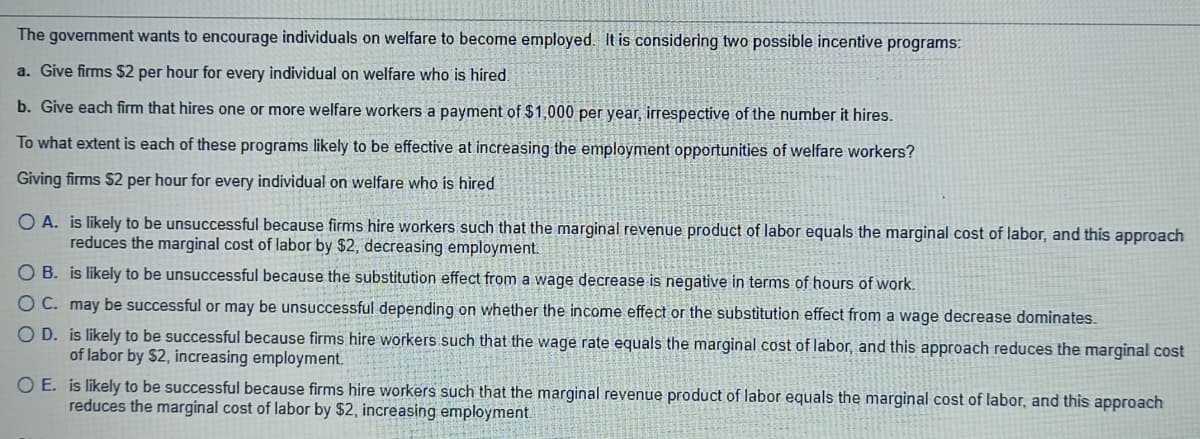The government wants to encourage individuals on welfare to become employed. It is considering two possible incentive programs: a. Give firms S2 per hour for every individual on welfare who is hired. b. Give each firm that hires one or more welfare workers a payment of $1,000 per year, irrespective of the number it hires. To what extent is each of these programs likely to be effective at increasing the employment opportunities of welfare workers? Giving firms $2 per hour for every individual on welfare who is hired O A. is likely to be unsuccessful because firms hire workers such that the marginal revenue product of labor equals the marginal cost of labor, and this approach reduces the marginal cost of labor by $2, decreasing employment. O B. is likely to be unsuccessful because the substitution effect from a wage decrease is negative in terms of hours of work. O C. may be successful or may be unsuccessful depending on whether the income effect or the substitution effect from a wage decrease dominates. O D. is likely to be successful because firms hire workers such that the wage rate equals the marginal cost of labor, and this approach reduces the marginal cost of labor by $2, increasing employment. O E. is likely to be successful because firms hire workers such that the marginal revenue product of labor equals the marginal cost of labor, and this approach reduces the marginal cost of labor by $2, increasing employment.
The government wants to encourage individuals on welfare to become employed. It is considering two possible incentive programs: a. Give firms S2 per hour for every individual on welfare who is hired. b. Give each firm that hires one or more welfare workers a payment of $1,000 per year, irrespective of the number it hires. To what extent is each of these programs likely to be effective at increasing the employment opportunities of welfare workers? Giving firms $2 per hour for every individual on welfare who is hired O A. is likely to be unsuccessful because firms hire workers such that the marginal revenue product of labor equals the marginal cost of labor, and this approach reduces the marginal cost of labor by $2, decreasing employment. O B. is likely to be unsuccessful because the substitution effect from a wage decrease is negative in terms of hours of work. O C. may be successful or may be unsuccessful depending on whether the income effect or the substitution effect from a wage decrease dominates. O D. is likely to be successful because firms hire workers such that the wage rate equals the marginal cost of labor, and this approach reduces the marginal cost of labor by $2, increasing employment. O E. is likely to be successful because firms hire workers such that the marginal revenue product of labor equals the marginal cost of labor, and this approach reduces the marginal cost of labor by $2, increasing employment.
Principles of Microeconomics
7th Edition
ISBN:9781305156050
Author:N. Gregory Mankiw
Publisher:N. Gregory Mankiw
Chapter19: Earnings And Discrimination
Section: Chapter Questions
Problem 9PA
Related questions
Question

Transcribed Image Text:The government wants to encourage individuals on welfare to become employed. It is considering two possible incentive programs:
a. Give firms $2 per hour for every individual on welfare who is hired.
b. Give each firm that hires one or more welfare workers a payment of $1,000 per year, irrespective of the number it hires.
To what extent is each of these programs likely to be effective at increasing the employment opportunities of welfare workers?
Giving firms $2 per hour for every individual on welfare who is hired
O A. is likely to be unsuccessful because firms hire workers such that the marginal revenue product of labor equals the marginal cost of labor, and this approach
reduces the marginal cost of labor by $2, decreasing employment.
O B. is likely to be unsuccessful because the substitution effect from a wage decrease is negative in terms of hours of work.
OC. may be successful or may be unsuccessful depending on whether the income effect or the substitution effect from a wage decrease dominates.
O D. is likely to be successful because firms hire workers such that the wage rate equals the marginal cost of labor, and this approach reduces the marginal cost
of labor by $2, increasing employment.
O E. is likely to be successful because firms hire workers such that the marginal revenue product of labor equals the marginal cost of labor, and this approach
reduces the marginal cost of labor by $2, increasing employment.
Expert Solution
This question has been solved!
Explore an expertly crafted, step-by-step solution for a thorough understanding of key concepts.
This is a popular solution!
Trending now
This is a popular solution!
Step by step
Solved in 2 steps

Knowledge Booster
Learn more about
Need a deep-dive on the concept behind this application? Look no further. Learn more about this topic, economics and related others by exploring similar questions and additional content below.Recommended textbooks for you

Principles of Microeconomics
Economics
ISBN:
9781305156050
Author:
N. Gregory Mankiw
Publisher:
Cengage Learning

Principles of Economics, 7th Edition (MindTap Cou…
Economics
ISBN:
9781285165875
Author:
N. Gregory Mankiw
Publisher:
Cengage Learning


Principles of Microeconomics
Economics
ISBN:
9781305156050
Author:
N. Gregory Mankiw
Publisher:
Cengage Learning

Principles of Economics, 7th Edition (MindTap Cou…
Economics
ISBN:
9781285165875
Author:
N. Gregory Mankiw
Publisher:
Cengage Learning




Microeconomics: Private and Public Choice (MindTa…
Economics
ISBN:
9781305506893
Author:
James D. Gwartney, Richard L. Stroup, Russell S. Sobel, David A. Macpherson
Publisher:
Cengage Learning